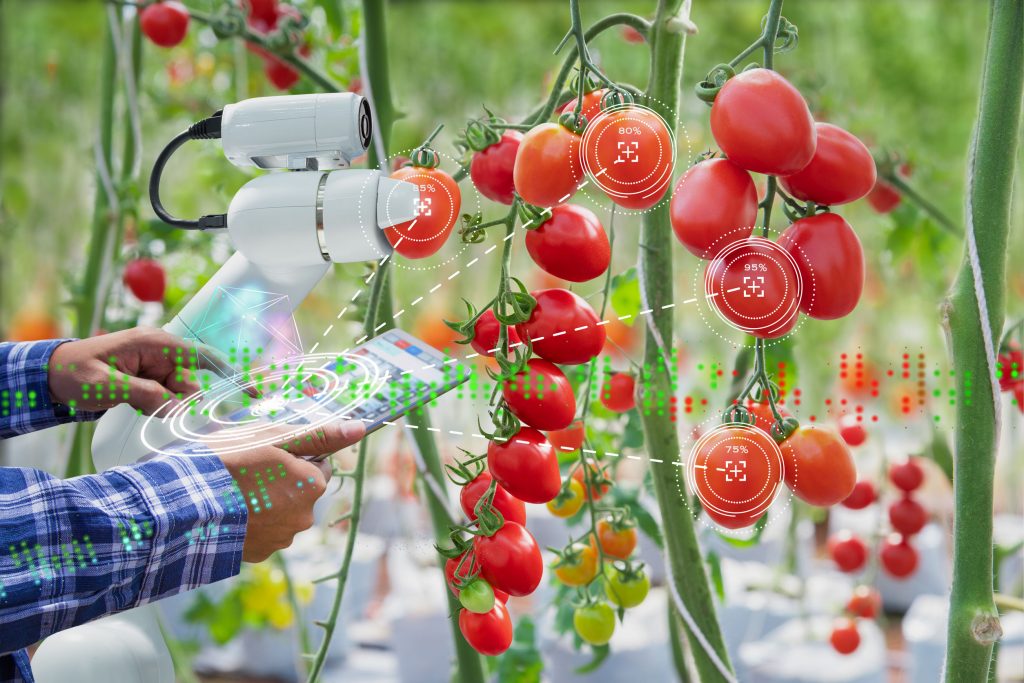The Future of Agriculture in the New Digital Age
Bottom line: Technology is changing farming and the whole agriculture value chain; this is good news for the farmer, retailer, and the consumer!
From drones firing seedlings across a vast farm area to self-driving tractors tilling the soil or harvesting massive tracts of wheat effortlessly, tech entrepreneurs are happily partnering with farmers to redefine agriculture in a mutually beneficial way.
Using revolutionary tools and computer chips-powered devices in all kinds of farm scenarios is just the tip of the iceberg; there is more, so much more!
Because data is now a precious commodity famously called ‘the new oil,’ farmers are happy to shell out a considerable quantity of their budget to acquire such intelligence geared towards precision farming.
Related: The future of the Chemical Industry in the 4th Industrial Revolution
Artificial Intelligence and the modern farmer

Deploying aerial imagery and GPS technology, a farmer in Cape Town can quickly tell where to concentrate more effort, how much rain the clouds will release, how much fertiliser to plan for, and more.
Similarly, electromagnetic soil mapping has contributed to reducing waste, cut cost, and significantly improve yield while, at the same time, increasing efficiency in the whole value chain.
Precise data about activities happening at the same time over thousands of hectares of farmland is the new normal.
Data sourced from specially crafted algorithms and statistical models are being applied across farms to significantly reduce lost working hours which, in turn, aims to eliminate redundancy and inefficiencies along the way.
Whether on lettuce farms, strawberry plantation, or open-field cattle grazing fields, Artificial Intelligence and Machine Learning are playing significant roles to help farmers get the best out of their crops, animals, and the land itself.
For instance, AI can crunch thousands of historical data points, analyse them in an instant, and produce trends or predictions covering many aspects that will impact on better farm productivity.
Such an advanced technology can predict future behaviour and reveal hidden patterns the human mind cannot comprehend in such a short period.
It can show the farmer crucial information like soil health, precise yield expectations, rapid weather changes, among others, through mobile applications on a smartphone.
Mobile apps are a farmer’s best friend – agriculture will never remain the same again!

Barring the present challenges of accessing a reliable broadband internet connection at remote farm locations (which telecoms companies are working hard to resolve), using a smartphone has become as decisive for a farmer success as receiving a considerable measure of rainfall is too.
No matter the operating system on their mobile devices, farmers will be able to access business-transforming apps that will make their farms more productive and produce more competitive in the local and international markets.
Sitting under the shed of a tree or relaxing inside a barn, a farmer can track just about everything, extract multiple records, and keep them ready at the tip of his or her fingers, literally.
The apps are here – and they are in their hundreds already, covering every aspect of farm life.
While ‘Farm At Hand’ is a free cloud-based farm management app for capturing field data, award-winning ‘Ross‘ is the perfect tool for poultry farmers to monitor the performance of their birds.
Similarly, ‘Growers Edge’ helps farmers stay in profit by aggregating historical and real-time commodity prices on the market just as ‘Citrus Pests Key’ allows farmers to quickly identify insect pests that could damage their citrus plants and yields.
There are other apps designed for just about anything on the farm.
Some help to improve spraying efficiencies, others connect farmers over vast areas in a collective where they share ideas, learn from one another, and even sell their crops online, seamlessly.
These apps are powerful tools built to eliminate time wastage, make work easier, reduce overhead costs, and ensure the farmer is on top of every situation.
Many are designed (or inspired by) active farmers for monitoring and evaluating the health and profitability of the farm which can be done by simply checking and responding to push notifications, group updates, instant messages, among others – all in one single smartphone or tablet.
Read also: The Future of IT Security in the Digital Age: An Opportunity for Africa to Arise!
Robots in the agriculture value chain

Just a few years ago, there were no robots to choose the best fruits, pluck them off acres of vineyards in a precise manner, or package nuts in segments for different markets.
Twenty years ago, watching autonomous tractors drive themselves over vast tracts of land or precision spraying machines decide where to spray water and pesticides were the stuff of dreams, wishful thinking of the weirdest engineering student, at best.
New technology has made sure all these are no more experimental; these machines are “alive,” walking and working on hundreds of farms across the world every day.
According to Goldman Sachs, the agriculture-tech and robotic industry could be worth as much as US$240 billion in no time. This projection is thanks to new development in materials and additive manufacturing (3D).
With 3D technology becoming steadily rife and affordable, mechanical parts and other components required for these robots and machines can be swiftly and cheaply manufactured and assembled in the remotest parts of the world, eliminating the cost of transporting them over borders.
The implications of such possibilities are mindboggling!
It means the farmer in the remotest farms in Limpopo or Northern Cape can get access to AI-controlled robots to milk and tend to his cattle or pick his apples at a fraction of the cost of hiring dozens of labourers to do the same job.
These machines are highly efficient, don’t take a leave of absence, and are always ready to work when required.
As replacement parts get cheaper and the technology to effect repairs gets widespread and readily available to local mechanics and engineers, this option is becoming more popular and inviting to African farmers.
Will technology replace farmlands and create more unemployment?

No!
The reverse is the case!!
Technology is not necessarily out there to displace farm hands; it is, in fact, an opportunity for low-skilled workers to get upskilled.
Drones to spray pesticides, robots to milk cows, and self-driving trucks are not entirely autonomous in every sense of the word – they still require skilled technicians to take care of them and ensure they function correctly.
In other words, what the farming industry is set to witness is a skills transformation period.
These technologies have opened up new opportunities – especially for young people.
For instance, a grape picker can learn how to fly and repair pest-monitoring drones; a dairy farm employee can learn how to code the program or debug errors that will ensure new cow-milking robots functions properly.
It’s a win-win for everybody.
Conclusion
The Fourth Industrial Revolution is set to transform the world, and the agriculture industry is at the frontline of that transformation considering that there are more mouths to feed with lesser rainfall, stressed farm soil, and diverse challenges in the value and supply chain.
If the 7.5 billion lot of the human species must remain well-fed with nutritious meals that are affordable and accessible, relying on these new (and many other) technology-driven tools is inevitable.
For the sake of food security (read: competitiveness for the farmer and affordability for the consumer), farmers, large and small, must begin transitioning their procedures to accommodate the Internet of Things (IoT), Artificial Intelligence, robotics, mobile app deployment, and related technology.
The government must, as well, encourage farmers in terms of putting in place the right regulations and policies.
This policy can address issues like investing in educating young people in the technologies of the future as well as creating an enabling environment so that the agriculture value chain will be as profitable for the farmer as it is accessible and affordable for the consumer.
End.
*Being outcome of a panel discussion on The future of the Agriculture Industry in the New Digital Age held at Regenesys Business School, Sandton, Johannesburg, in partnership with Farmers Weekly (Caxton Media) and Landbouweekblad (Media 24), on the 19th of September 2019.
The Panel comprised of Industry Subject-Matter Experts, Small- and Large-holder Farmers, the Academia, and the Public.
The Panelists included:
- Omri van Zyl, CEO, AGRISA
- Denene Erasmus, Editor, FARMERS WEEKLY
- Liza, Bohlmann, Head of Special Projects, LANDBOUWEEKBLAD
- Willie Jacobs, Agricultural Finance Specialist Consultant and Deal Facilitator, INTO AFRICA SOLUTIONS SERVICES
- Wessel Lemmer, Senior Agricultural Economist, ABSA
- Jolanda Andrag, Head: Commodity Chamber, AGRISA
- Riaan Agenbag, Economist, Analyst & CEO, Agenbag’s All Trade Close Corporation
- Andre Pretorius, Marketing Communication Manager: Agricultural Solutions, BASF






